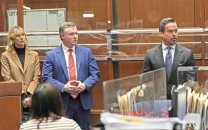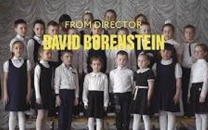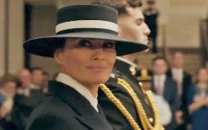In memoriam: Sikander Sanam – father of ‘Part 2’ films
The Express Tribune remembers man behind parody of ‘Tere Naam’ on his death anniversary

Sanam spent most of his career entertaining audiences at stage plays while being at the receiving end of slaps from lead comedians such as Umar Sharif. PHOTO: PUBLICITY
Following the turn of the 1990s and the eventual break of the 21st century, there were at least three occasions that forced many to reconsider their hairstyle preferences – Lady Diana’s visit to Pakistan and the releases of Bollywood films Tere Naam (2003) and Ghajini (2008).
Two of these were somewhat restricted to haggling behind the walls of roadside barber shops and high-end beauty parlours. But Satish Kaushik’s Salman Khan-starrer Tere Naam triggered another trend that became all the rage with Karachi’s stage comedians who were on the breadline for more than one reason – parodies of Bollywood hits.
Hate the way TV works: Kapil Sharma
In the thick of this current, whose potency was largely underrated, was none other than Sikandar Sanam. Perched up on a stool in a makeshift make-up room, making sure his overgrown gelled hair was parted right from the middle in a way that the locks on either side curled enough to reach his nostrils. Tere Naam Part II was a mindless attempt at reworking the popular story of Radhe Mohan, who falls in love with a girl and ends up in a mental asylum.
Sponsored by local supari manufacturers, it followed the flow of the original film, only punctuated with humour that Sanam and his brethren had been spinning for years on the stage of dilapidated auditoriums and theatres situated in Karachi’s underdeveloped areas. Although the film made sense exactly the way Salman’s contemporary films do, it somewhat clicked with the audiences.
‘Our standard of comedy has declined since PTV days’
These films earned his contemporaries such as Rauf Lala, and juniors such as Ali Hasan and Irfan Malik, tickets to India, where standup comedy was seeing a rebirth on national TV. The man, whose brainchild Tere Naam Part II paved way for a wave of such films, was granted entry to ‘The Great Indian Laughter Challenge’ only when the show had completed three full seasons.
When Sanam was diagnosed with liver cancer that eventually got the better of him on November 5, 2012, he chose to rely on Nawabshah’s quack healers instead of standard treatment facilities – a choice that was palpably sparked by economic restrictions and the man’s undying characteristic of not taking favours.
Talking to The Express Tribune, veteran stage director Nazar Hussain said, “Sanam was way ahead of his time. Despite the presence of giants such as Umar Sharif and Shakil Siddiqui, he made a name for himself.” Hussain added that never in his life did he come across another performer like Sanam who could improvise like no one else. “He died just when doors had begun to open up for him … he left us too soon. The loss is irreparable.”
Sanam was a strange man among the lot. Born Muhammad Sikander to a poet of some repute, he adopted the stage name in search of gaining acclaim with those who did not discriminate between artists who hailed from areas such as Lalu Khet and Paposh. He spent most of his career years entertaining audiences at stage plays while being at the receiving end of slaps from lead comedians such as Umar Sharif, sharing jokes on his skin colour and frail body.
Sanam belonged to the class of entertainers who seldom understood why ‘evolved’ audiences wrote them off, terming their humour crass, bawdy and politically-incorrect. While for some these never existed, others were having the time of their life consuming their ‘Part II’ films, thanks to the unbridled introduction of TV channels run by cable operators and electronic markets laden with cheap DVD, VCD players like the season’s fruit in those years.
Published in The Express Tribune, November 5th, 2015.
Like Life & Style on Facebook, follow @ETLifeandStyle on Twitter for the latest in fashion, gossip and entertainment.



















COMMENTS
Comments are moderated and generally will be posted if they are on-topic and not abusive.
For more information, please see our Comments FAQ